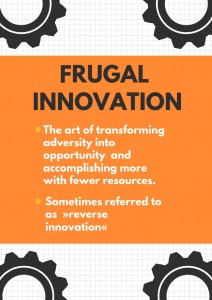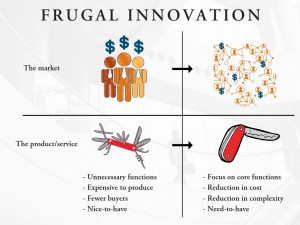What does frugal innovation have to do with your work as an independent consultant? I will tell you. Did you as an IT-consulting ever experienced the pressure of creating miracles during extreme time pressure and with limited ressources? In the TED-talk below, Innovation and Management Advisor Navi Radjou, teaches you how to transform adversity into opportunity and how to find creative ways to rethink the tools you have already got.
Democratic and sustainable innovation
The preferred business model in the West has long been the driving force for rapid technological development. This has enriched our society in many ways. But constantly aiming for the new ‘it’ has its backsides and makes it difficult to rethink and develop already existing products. Once a product has been launched, this model will try to reinvent the wheel over and over again. It is an innovative model that does not allow developing existing products or services which is very demanding and corrosive to the world’s resources. This is where frugal innovation comes into play. As a counter-movement driven both by the desire to make products and services available to the billions of people who have limited purchasing power and to spare our globe by thinking more sustainable.
Reverse innovation – turn the approach to innovation development upside-down
Frugal innovation is a process of reducing complexity and costs for a given product or service. Popularly, you cut to the bone to specify and exclusively focus on the product’s or service core functions. In reverse innovation your main goal is to focus on what is ‘need to have’ rather than implementing inessential and expendable attributes to it. You reduces the complexity and hereby the price to a level that will benefit both people localy in your respected field and worldwide.
Safaricom – mobile banking for Kenya’s inhabitant without banking access
A specific example of tech-based frugal innovation, is the transfers and savings of money completely without a bank account. While mobile phones are becoming widely spread in Kenya, there are still many inhabitants without a bank account. The mobile service provider Safaricom discovered this gap and saw its potential. Because of them, the inhabitants are now able to make money transfers and save money through their mobile account. This makes life easier and safer for them.
Frugal innovation requires changes in your thought pattern
Frugal innovation can be an incentive to rethink your company’s innovation- and growth strategy. Everyone in the business can benefit from it. As a start-up, one-man business or freelance. It can be difficult to find your niche in a competetive market, that is why you should take the following 5 frugal innovation bulletpoints into consideration:
- Stand out using reverse innovation. Where others only see opportunities in expensive resource-intensive projects, you may be able to see solutions in the already existing. In an industry built on differentiation and innovation, this might be the niche that makes you special and in great demand.
- Innovate your workflow. Rethink what you as an individual can offer. Get inputs from Navi Radjous TED-talk to create an innovative thought pattern that seperates you from your competitors.
- Involve all stakeholders. Take advantage of the knowledge that lies with those who already works with the service or with the product you want to innovate. In order to specify your focus on the service and product’s core functions, you should always involve both your costumer, suppliers and end-costumers.
- Use and cultivate your (innovation-) network. As an extension of the above, you can advantageously extend even further, to test and develop your ideas. Think crowd-creation or get yourself a network of business partners from other disciplines that also focuses on frugal innovation. It is important to be able to spar with others who wants to innovate within the same area as you.
- Think sustainability. Sustainability in frugal innovation is to be understood broadly: no unnecessary use of ressources, utility for the majority etc. quality over quantity. Sustainability is a main focus for many companies, for example as part of a CSR-strategy. By ensuring this focus, you also add value to the generic product.
Innovation that resonates
Why not think innovation on existing products, services or resources and improve these instead of deleoping new things that are unnecessarily expensive and complex? This is where Navi Radjou hits the head on the nail: “I think of the individuals who devise them as being like alchemists: they can magically transform adversity into opportunity, turning something of low value into something of high value.” In other words, they master the art of doing more with less. This is the essense of frugal innovation.
Innovation under construction
Frugal innovation has primarely been used in emerging markets, or in companies with limited resources, but in 2012 The Economist also recognized the potential for the Western world to innovate in the reversed way: “[Radjou and his co-authors] argue convincingly that frugal innovation will change rich countries, too”. Next Billion also states that his type of innovation is not limited to low-tech sectors. There is a huge unresolved potential in the way the IT-industry works in the West, and in order to change this companies should be able to embrace frugal innovation. The quotation from The Economist is a clear sign of a long-lasting change process, where the companies starts to implement frugal innovation in practice.
Is the IT-industry prepared for the future
In 2011, the Danish company Strategos made the report ‘Is the IT-industry prepared for the future?’ 126 of the respondents are CEO’s in the IT-industry. The report has three major points:
- IT-companies experiences to only execute on 60% of their potential. This is below average for other industries.
- 70% have growth ambitions of over 10% in their strategy.
- IT-companies need to become more agile.
It is a report that is eight years old, but relevant as never before. The percentages show clear signs of a unresolved potential in the industry. Frugal innovation could never stand alone in the pursuit of higher growth rates, but must be an incentive to also see opportunities for renewal in existing products and services. In the long run, it will be possible to see the impact of the implementation of frugal innovation. Frugal innovation can be a tool to reach out to completely new markets, because the product or service can be offered at a lower price and can be adapted to a different usage context than the one we are used to in our part of the world.











